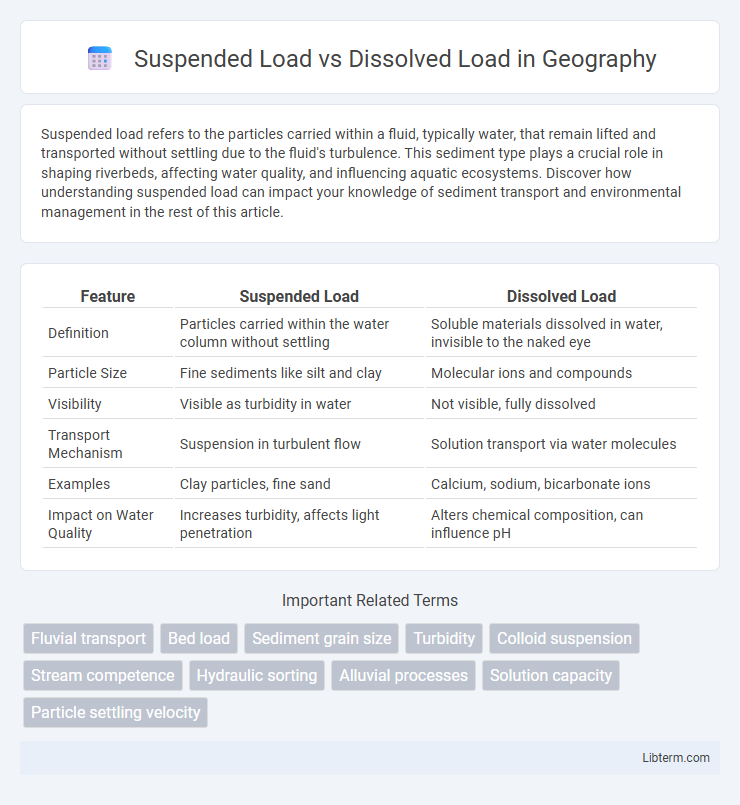Suspended load refers to the particles carried within a fluid, typically water, that remain lifted and transported without settling due to the fluid's turbulence. This sediment type plays a crucial role in shaping riverbeds, affecting water quality, and influencing aquatic ecosystems. Discover how understanding suspended load can impact your knowledge of sediment transport and environmental management in the rest of this article.
Table of Comparison
| Feature | Suspended Load | Dissolved Load |
|---|---|---|
| Definition | Particles carried within the water column without settling | Soluble materials dissolved in water, invisible to the naked eye |
| Particle Size | Fine sediments like silt and clay | Molecular ions and compounds |
| Visibility | Visible as turbidity in water | Not visible, fully dissolved |
| Transport Mechanism | Suspension in turbulent flow | Solution transport via water molecules |
| Examples | Clay particles, fine sand | Calcium, sodium, bicarbonate ions |
| Impact on Water Quality | Increases turbidity, affects light penetration | Alters chemical composition, can influence pH |
Introduction to Sediment Transport
Suspended load consists of fine particles like silt and clay that remain uplifted in the water column due to turbulence during sediment transport, whereas dissolved load involves minerals and ions chemically dissolved in water. Sediment transport dynamics rely heavily on the interaction between these loads, influencing river morphology and water quality. Understanding the balance between suspended and dissolved loads is crucial for predicting erosion, deposition patterns, and sediment budgets in hydrological systems.
Defining Suspended Load
Suspended load refers to fine sediment particles such as silt and clay that are carried within the water column without settling to the bed, transported by the turbulent flow of a river or stream. It contrasts with dissolved load, which consists of soluble materials like minerals and ions dissolved in water. Understanding the suspended load is crucial for sediment transport studies, river morphology, and water quality assessments.
Understanding Dissolved Load
Dissolved load refers to minerals and soluble substances transported in water in ionic form, originating primarily from chemical weathering of rocks. Unlike suspended load, which consists of larger particles carried within the water column, dissolved load is invisible and contributes significantly to the total sediment yield of rivers. This load plays a crucial role in shaping water chemistry and influencing aquatic ecosystems by supplying essential nutrients and altering pH levels.
Key Differences Between Suspended and Dissolved Loads
Suspended load consists of fine particles like silt and clay that remain buoyant within the water column due to turbulence, while dissolved load comprises ions and soluble minerals carried within the water in a true solution. Suspended load impacts water turbidity and sediment deposition patterns, whereas dissolved load influences water chemistry and nutrient availability. The transport mechanisms differ as suspended load is physically moved by flowing water, and dissolved load is chemically transported through mineral dissolution and ion exchange.
Sources of Suspended and Dissolved Loads
Suspended load primarily originates from soil erosion, surface runoff, and bank erosion, consisting of fine particles like silt and clay carried within river water. Dissolved load comes from the chemical weathering of minerals, groundwater seepage, and the dissolution of soluble rocks such as limestone and gypsum. Understanding these sources is crucial for assessing sediment transport and water quality in fluvial systems.
Measurement Techniques for Sediment Loads
Suspended load measurement techniques typically involve collecting water samples using depth-integrated samplers or automatic samplers to analyze sediment concentration through filtration and weighing. Dissolved load is measured by filtering water samples through fine filters followed by chemical analysis using spectrometry or ion chromatography to quantify dissolved minerals and ions. Advances in optical sensors and in-situ turbidity probes provide continuous data for suspended sediment, while dissolved load requires laboratory-based chemical assays for accurate quantification.
Environmental Impacts of Suspended and Dissolved Loads
Suspended load consists of fine particles like silt and clay that remain in water columns, causing turbidity and reducing light penetration, which adversely affects aquatic ecosystems and disrupts photosynthesis. Dissolved load comprises minerals and nutrients in solution that can lead to eutrophication, promoting harmful algal blooms and depleting oxygen levels in water bodies. Both suspended and dissolved loads contribute to sedimentation and chemical imbalances, impacting water quality and biodiversity in rivers, lakes, and coastal areas.
Factors Affecting Load Composition in Rivers
Suspended load in rivers consists of fine particles like silt and clay carried within the water column, while dissolved load comprises ions and soluble materials transported in solution. Factors affecting load composition include river velocity, which influences the capacity to keep particles suspended or settle; catchment geology, determining the mineral content of dissolved ions; and weathering processes that regulate the release of sediments and solutes. Seasonal variations, land use changes, and human activities such as deforestation and agriculture also significantly impact the balance between suspended and dissolved loads.
Significance in River Ecosystems
Suspended load consists of fine particles like silt and clay transported within the water column, playing a crucial role in nutrient distribution and habitat formation in river ecosystems. Dissolved load involves soluble materials such as minerals and salts critical for maintaining water chemistry and supporting aquatic life's physiological processes. Both loads influence sediment delivery, water quality, and biological productivity, shaping river morphology and ecosystem health.
Managing and Reducing Sediment Loads
Managing sediment loads requires distinguishing between suspended load, consisting of fine particles carried within the water column, and dissolved load, which includes minerals and ions in solution. Effective strategies for reducing suspended load focus on erosion control, riparian buffer zones, and sediment traps, while dissolved load reduction involves controlling chemical inputs and improving land use practices to minimize pollutant runoff. Monitoring sediment sources and applying tailored management plans are essential for protecting water quality and aquatic ecosystems.
Suspended Load Infographic

 libterm.com
libterm.com